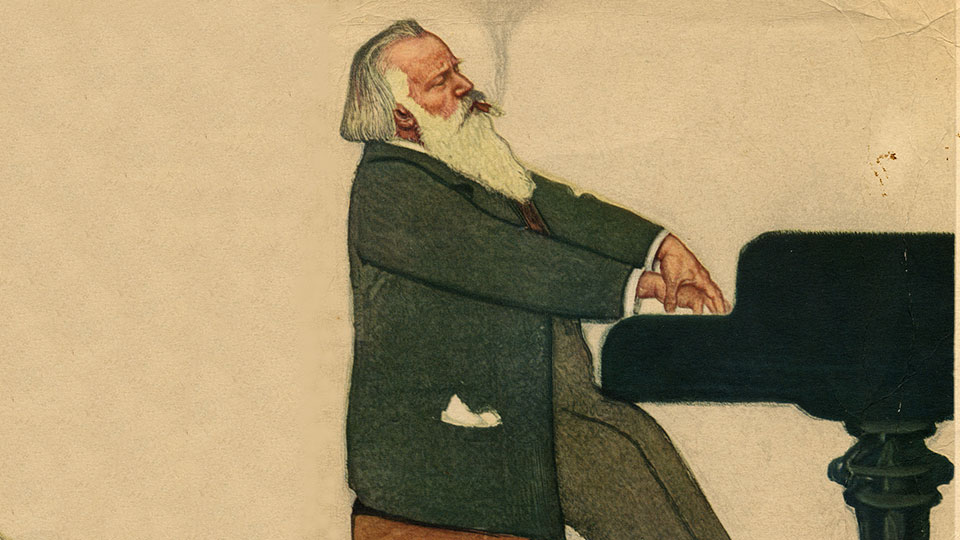Johannes Brahms (1833–1897) stands as one of the towering figures in classical music, celebrated for his deep, complex compositions that marry technical mastery with profound emotional depth. His oeuvre spans a range of genres, each revealing a different facet of his genius. Here, we explore ten of his most celebrated compositions, each a testament to his enduring legacy.
1. Symphony No. 1 in C Minor, Op. 68 (1876)
Often dubbed “Beethoven’s Tenth” due to its profound debt to Beethoven’s symphonic style, Brahms’ Symphony No. 1 took over 14 years to complete. Its stormy opening gives way to a majestic and triumphant finale, marked by the famous alphorn theme. This work established Brahms as a worthy successor to Beethoven, merging rigorous structure with Romantic expressiveness.
- Key Features: Dramatic opening, serene slow movement, majestic finale.
- Notable Recordings: Berlin Philharmonic Orchestra, conducted by Herbert von Karajan.
2. A German Requiem, Op. 45 (1868)
A deeply personal and spiritual work, A German Requiem is Brahms’ response to the deaths of his mother and Robert Schumann. Unlike traditional requiems, it sets texts from the German Bible rather than the Latin liturgy, offering comfort to the living rather than focusing on the souls of the dead. Its seven movements range from the consoling “Blessed are they that mourn” to the powerful “How lovely is thy dwelling place.”
- Key Features: Lush choral textures, contemplative and uplifting.
- Notable Recordings: Vienna Philharmonic, conducted by Herbert von Karajan.
3. Violin Concerto in D Major, Op. 77 (1878)
Brahms’ Violin Concerto is a staple of the violin repertoire, combining lyrical beauty with technical challenges. Written for the great violinist Joseph Joachim, it features a soulful Adagio and a fiery, Hungarian-inspired finale. The interplay between soloist and orchestra showcases Brahms’ skill in balancing virtuosity with orchestral richness.
- Key Features: Expressive slow movement, virtuosic cadenza.
- Notable Recordings: Itzhak Perlman with the Chicago Symphony Orchestra, conducted by Daniel Barenboim.
4. Piano Concerto No. 2 in B-flat Major, Op. 83 (1881)
This monumental concerto is known for its grandeur and scope. Its four movements, rather than the usual three, allow for a more expansive emotional and musical journey. The third movement features a prominent cello solo, adding a unique lyrical element. The work requires immense stamina and finesse from the pianist.
- Key Features: Four-movement structure, dramatic and lyrical contrasts.
- Notable Recordings: Emil Gilels with the Berlin Philharmonic, conducted by Eugen Jochum.
5. Symphony No. 4 in E Minor, Op. 98 (1885)
Brahms’ final symphony is often considered his greatest, marked by its tragic power and architectural mastery. The final movement is a chaconne, a form that weaves variations over a repeated bass line, demonstrating Brahms’ command of both form and emotional depth. The symphony’s melancholy and intensity make it a pinnacle of Brahms’ symphonic writing.
- Key Features: Innovative chaconne finale, dramatic themes.
- Notable Recordings: Berlin Philharmonic, conducted by Wilhelm Furtwängler.
6. Piano Quintet in F Minor, Op. 34 (1864)
Originally conceived as a string quintet and later arranged as a sonata for two pianos, this work found its final and most effective form as a piano quintet. Its dark, brooding character and dynamic contrasts make it one of the most compelling pieces in the chamber music repertoire. The interplay between piano and strings is both intricate and powerful.
- Key Features: Tense, dramatic interplay between instruments.
- Notable Recordings: The Juilliard String Quartet with Leonard Bernstein.
7. Hungarian Dances, WoO 1 (1869-1880)
This collection of 21 lively dances, inspired by Hungarian folk music, showcases Brahms’ lighter, more popular side. Originally written for piano four-hands, they have been orchestrated by various composers, bringing out their rhythmic verve and melodic charm. The most famous is the Hungarian Dance No. 5 in F# Minor, known for its infectious energy.
- Key Features: Rhythmic vitality, folk-inspired melodies.
- Notable Recordings: The Vienna Philharmonic, conducted by Claudio Abbado.
8. Clarinet Quintet in B Minor, Op. 115 (1891)
Composed during his late period, this quintet reflects Brahms’ autumnal, introspective style. Written for the clarinetist Richard Mühlfeld, it features lush harmonies and a poignant, lyrical quality. The work balances warmth and melancholy, showcasing Brahms’ ability to write deeply expressive chamber music.
- Key Features: Rich, lyrical clarinet writing, autumnal mood.
- Notable Recordings: Thea King with the Gabrieli String Quartet.
9. Piano Trio No. 1 in B Major, Op. 8 (1854, revised 1889)
Brahms revised this early work extensively, transforming it into one of his most beloved chamber pieces. The revised trio blends youthful passion with the mature compositional techniques of his later years. Its themes are memorable and its emotional range wide, from the exuberant to the introspective.
- Key Features: Memorable themes, balanced structure.
- Notable Recordings: Beaux Arts Trio.
10. Symphony No. 2 in D Major, Op. 73 (1877)
Often described as Brahms’ “Pastoral Symphony,” the Second Symphony is lighter and more serene than his first. It is suffused with a sense of joy and lyrical beauty, with a radiant final movement. The symphony’s pastoral character and optimistic tone contrast sharply with the drama of his first symphony.
- Key Features: Lush orchestration, serene and joyful mood.
- Notable Recordings: Vienna Philharmonic, conducted by Leonard Bernstein.
Conclusion
Johannes Brahms’ compositions reveal a mastery of form and a depth of emotion that continues to resonate with audiences today. His ability to balance innovation with respect for classical traditions makes his works timeless. From the dramatic power of his symphonies to the intimate expressiveness of his chamber music, Brahms’ legacy is one of profound and enduring beauty. Each of these compositions offers a unique glimpse into his genius, ensuring his place as one of the greatest composers in the Western classical tradition.


Comments are closed